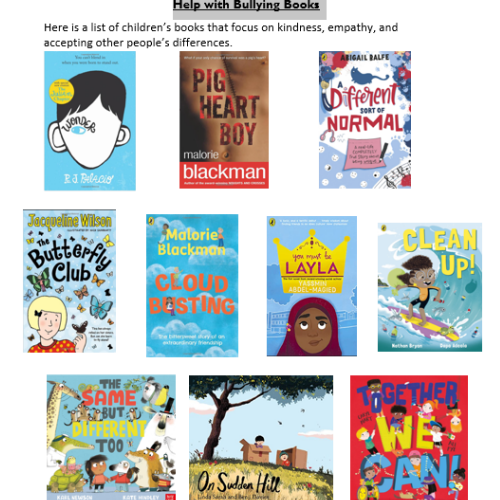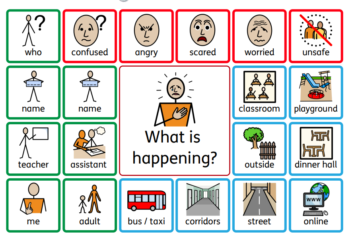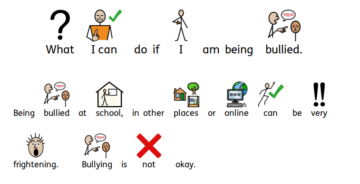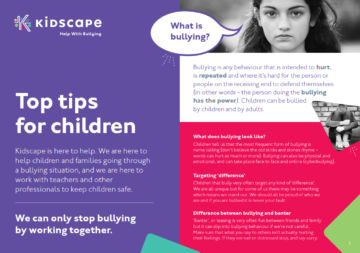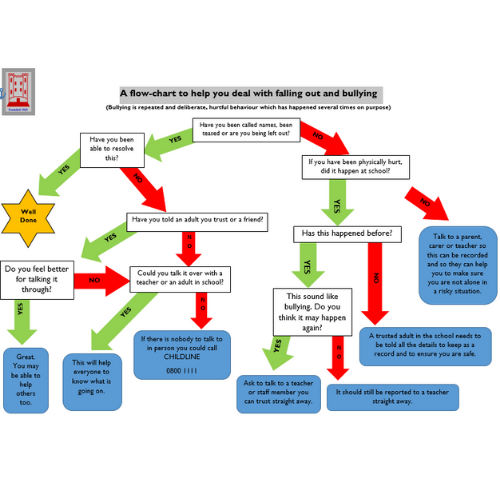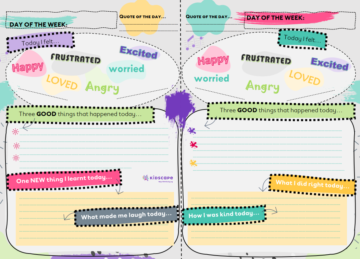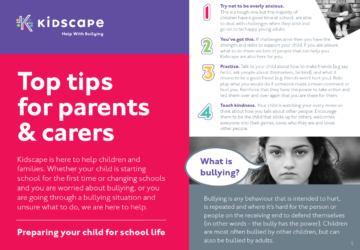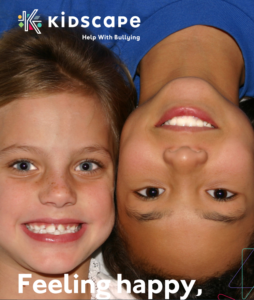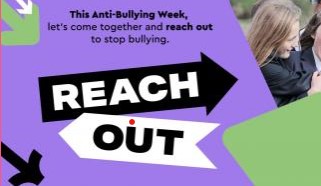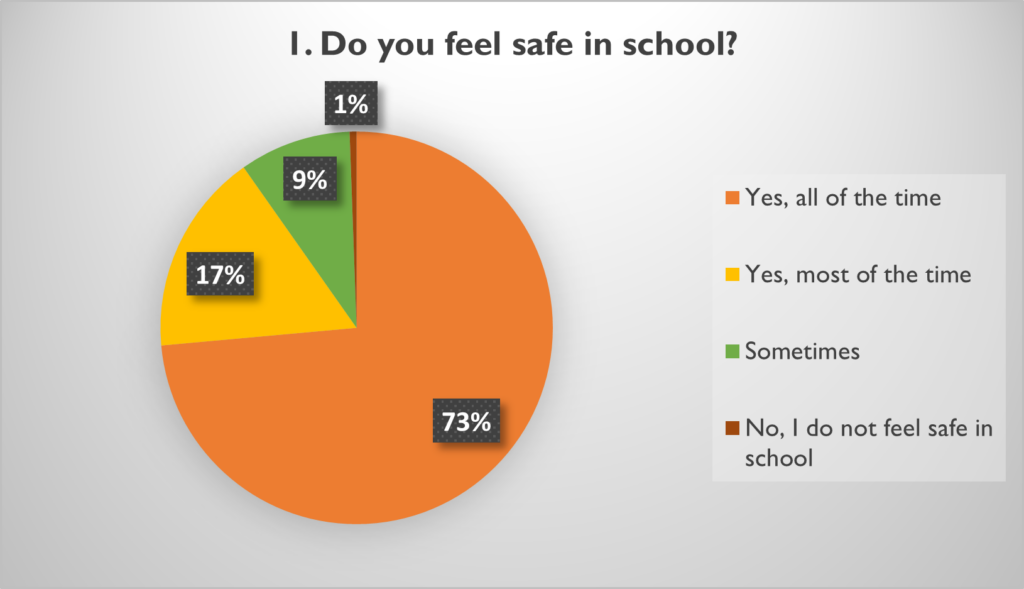Help with Bullying
Bullying is any behaviour that is intended to burt, is repeated and where it’s hard for the person or people on the receiving end to defend themsleves (in other words – the bully has the power). Children are most often bullied by other children, but can also be bullied by adults.
What does bullying look like?
Hurtful behaviour takes many forms but children tell us that the most frequent form of bullying is name calling (don’t believe the old sticks and stones rhyme – words hurt more than anything). Bullying can also be physical and emotional, and can take place face to face and online (cyberbullying). Interestingly, children tell us that that the face-to-face stuff is the hardest.
Targeting ‘difference’
Children that bully, very often target any kind of perceived ‘difference’. Sadly this means that disabled children and those with special educational needs, children with any kind of disfigurement, young carers, children in care, children from a minority ethnic background, children living in poverty, children who are bereaved, children with allergies, children who do not conform to gender ‘norms’ or are exploring their sexuality are very often targets.
Information taken from Kidscape ‘Help with Bullying’ leaflet for schools
What is NOT bullying
When talking about bullying, it is very important for parents (teachers and children) to understand what is not bullying. Many times, a single act or behaviour is out of proportion, but it is not considered bullying.
Some people think that bullying is any aggressive behaviour and although such behaviours are a source of concern and need attention, it is important to separate them from bullying. Bullying is recurring and a deliberate abuse of power.
At William Gilbert School we educate children to understand the difference between a deliberate act and an accidental one.
Much like in any communication, whether it is verbal or not, there are two sides involved. Bullying is a form of communication and depends not only on the giver but also on the receiver.
For an incident to be considered bullying, the aggressor must want to hurt someone, and the victim must perceive the incident as a deliberate act of abuse.
It is very important for the victim to know what is not bullying to make sure that when things seem hurtful, they will not fall immediately into the category of bullying, because the way to overcome bullying is different from the way to overcome other hurtful acts.
Not bullying list
The incidents on this list are NOT considered bullying:
But please remember that, at William Gilbert we work with children at school to diminish such incidents and support children when they occur.
- Not liking someone – It is very natural that people do not like everyone around them and, as unpleasant as it may be to know someone does not like you, verbal and non-verbal messages of “I don’t like you” although unkind, are not acts of bullying.
- Accidentally bumping into someone – When people bump into others, the reaction depends mostly on the bumped person’s mood. If they have had a bad day, they think it was an act of aggressive behaviour, but if they are in the good mood, they smile back and attract an apology. This is also relevant for playing sport, like when kids throwing the ball at each other hit someone on the head. It is very important for teachers and parents to explain that some accidents happen without any bad intention, and it is important not to create a big conflict, because it was NOT an act of bullying.
- Making other children play things a certain way – Again, this is very natural behaviour. Wanting things to be done our way is normal and is not an act of bullying. To make sure children do not fall into considering it as an aggressive or “bossy” behaviour, we need to teach them assertiveness. Again, although it is not fun or pleasant, this is NOT bullying.
- A single act of telling a joke about someone – Making fun of other people is not fun for them, it is important to teach children (and grownups) that things they say as jokes should also be amusing for the others. Friendly joking is where someone says funny things or plays tricks on someone to make that person laugh. Joking is between friends and isn’t meant to be cruel or unkind. Joking doesn’t make anybody feel bad, and always stops before anyone gets upset. If others do get upset, they should stop. Unless it happens over and over again and done deliberately to hurt someone, telling jokes about people is NOT bullying.
- Arguments – Arguments are just heated disagreements between two (or more) people (or groups). It is natural that people have different interests and disagree on many things. Think about it, most of us have disagreements with ourselves, so it is very understandable to have disagreements with others. The argument itself is NOT a form of bullying, although some people turn arguments into bullying, because they want to win the argument so much. They use every means to get what they want and find a weakness in the other person, abuse knowledge or trust they have gained and use it against the other person. It is very important to distinguish between natural disagreements and bullying during an argument.
- Expression of unpleasant thoughts or feelings regarding others – Again, communication requires at least two players. Although it may be unpleasant to hear what someone thinks about you, it is NOT a form of bullying but a very natural thing. In every communication, there are disagreements and some form of judgment about each other’s attitude and behaviour. If someone says to you, “I think this was not a nice gesture” or “You insulted me when you said this”, this is NOT bullying but an expression of thoughts and feelings.
- Isolated acts of harassment, aggressive behaviour, intimidation, or meanness – The definition of bullying states that there is repetition in the behaviour. Bullying is a conscious, repeated, hostile, aggressive behaviour of an individual or a group abusing their position with the intention to harm others or gain real or perceived power.
Therefore, anything that happens once is NOT an act of bullying. As a parent, it is important that you pay attention to what your children are telling you and find out if things are happening more than once. Encourage your child to tell a trusted adult when things happen so they can be acted upon immediately.
All the behaviours above are unkind, unpleasant and need to be addressed, but they are not to be treated as bullying.
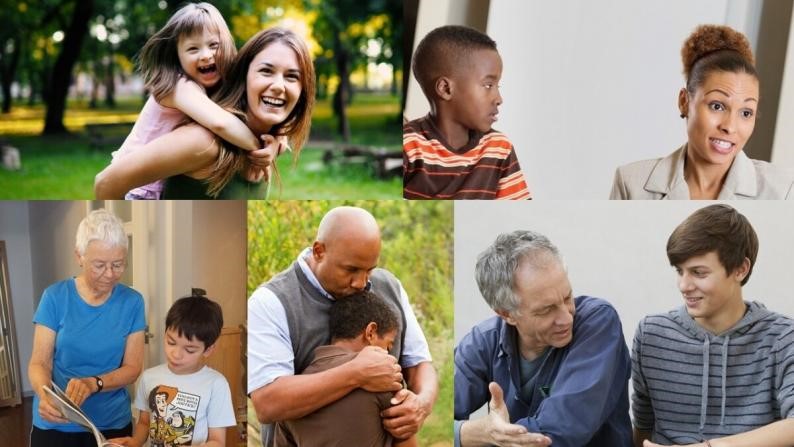
Resources for Children
Resources for Parents
Websites for advice, resources and support
Books that focus on kindness, empathy, and accepting other peoples differences
